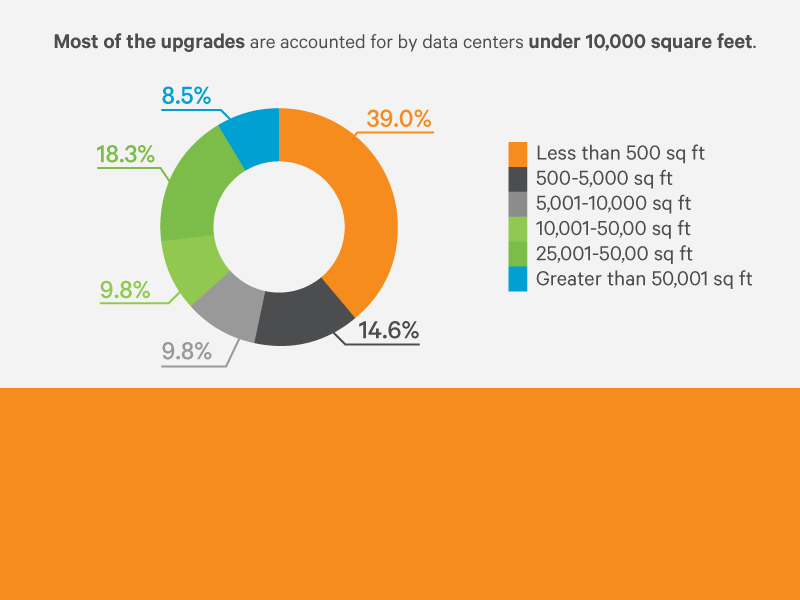Fans that move air and pressurize the data center’s raised floor are significant components of cooling system energy use. After mechanical cooling, fans are the next largest energy consumer on computer room air condition (CRAC) units.
One way many data center managers reduce energy usage and control their costs is by investing in variable speed fan technology. Such improvements can save fan energy consumption by as much as 76 percent.
With the different options on the market, it may not be clear which technology is best. Today, variable speed drives (VSDs)—also referred to as variable frequency drives or VFDs—and electrically commutated (EC) fans are two of the most effective fan improvement technologies available.
The advantages of both options are outlined below to help data center managers determine which fan technology is best for achieving energy efficiency goals.
How do different fan technologies work?
Variable speed fan technologies save energy by enabling cooling systems to adjust fan speed to meet the changing demand, which allows them to operate more efficiently.
While cooling units are typically sized for peak demand, peak demand conditions are rare in most applications. VSDs and EC fans more effectively match airflow output with load requirements, adjusting speeds based on changing needs. This prevents overcooling and generates significant energy savings.
With VSDs, drives are added to the fixed speed motors that propel the centrifugal fans traditionally used in precision cooling units. The drives enable fan speed to be adjusted based on operating conditions, reducing fan speed and power draw as load decreases. Energy consumption changes dramatically as fan speed is decreased or increased due to the fan laws. For this reason, a 20 percent reduction in fan speed provides nearly 50 percent savings in fan power consumption.
EC fans are direct drive fans that are integrated into the cooling unit by replacing the centrifugal fans and motor assemblies. They are inherently more efficient than traditional centrifugal fans because of their unique design, which uses a brushless EC motor in a backward curved motorized impeller.
EC fans achieve speed control by varying the DC voltage delivered to the fan. Independent testing of EC fan energy consumption versus VSDs found that EC fans mounted inside the cooling unit created an 18 percent savings. With new units, EC fans can be located under the floor, further increasing the savings.
How do VSDs and EC fans compare?
Energy Savings One of the main differences between VSDs and EC fans is that VSDs save energy when the fan speed can be operated below full speed. VSDs do not reduce energy consumption when the airflow demands require the fans to operate at or near peak load. Conversely, EC fans typically require less energy even when the same quantity of air is flowing.
This allows them to still save energy when the cooling unit is at full load. EC fans also distribute air more evenly under the floor, resulting in more balanced air distribution. Another benefit of direct-drive EC fans is the elimination of belt losses seen with centrifugal blowers. Ultimately, EC fans are the more efficient fan technology.
Cooling Unit Type VSDs are particularly well-suited for larger systems with ducted upflow cooling units that require higher static pressures, while EC fans are better suited for downflow units.
Maintenance In terms of maintenance, EC fans offer an advantage. EC fans also reduce maintenance because they have no fan belts that wear and their integrated motors virtually eliminate fan dust.
Installation Both VSDs and EC fans can be installed on existing cooling units or specified in new units. When installing on existing units, factory-grade installation is a must.
Payback In many cases, the choice between VSDs and EC fans comes down to payback. If rapid payback is a priority, then VSDs are likely the better choice. These devices can offer payback in fewer than 10 months when operated at 75 percent. However, EC fans will deliver greater, long-term energy savings and a better return on investment (ROI). While EC fans can cost up to 50 percent more than VSDs, they generate greater energy savings and reduce overall maintenance costs, ultimately resulting in the lowest total cost of ownership.
Have the experts weigh in
Service professionals can be an asset in helping choose the best fan technology for a data center. Service professionals can calculate the ROI from both options, and they can recommend the best fan technologies for specific equipment.
Service professionals trained in optimizing precision cooling system performance can also ensure factory-grade installations, complete set point adjustment to meet room requirements, and properly maintain equipment, helping businesses achieve maximum cooling unit efficiency today and in the future.
Whether you ultimately decide to go with VSDs or EC fans, either way, you’ll be rewarded with a greener data center, more efficient cooling, and significant energy savings that translate into a better bottom line.



